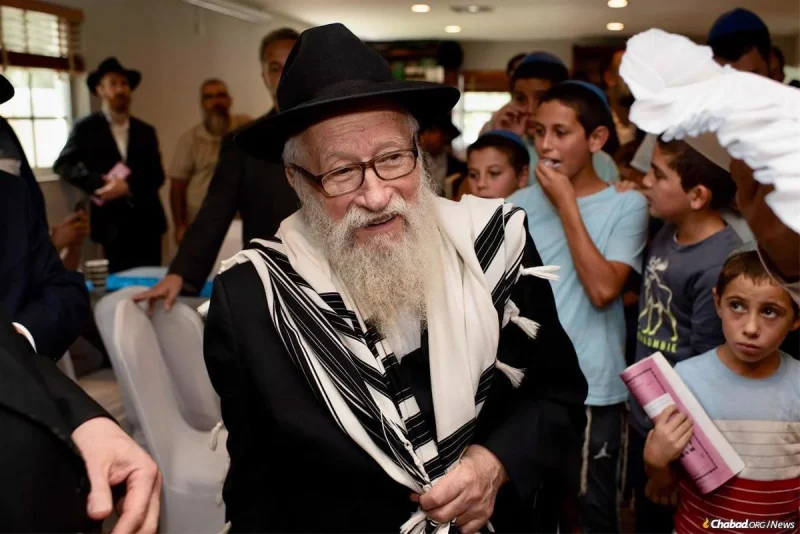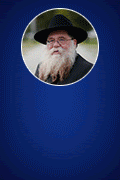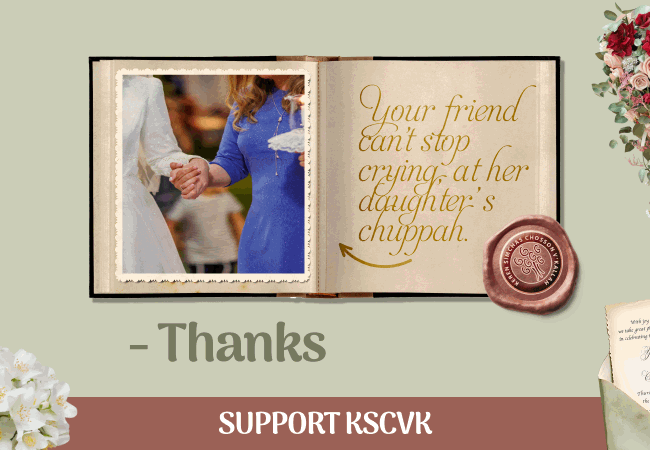
Rabbi Avraham Korf Built Florida Empire, Remained Dedicated Soldier
by Motti Wilhelm – chabad.org
In terms of sheer numbers, the network built by Rabbi Avraham Korf, regional director of Chabad-Lubavitch of Florida, is staggering. There are today nearly 400 Chabad emissary couples serving all over the state. These couples build and sustain communities stretching from Key West in the south to Jacksonville in the north, and from Pensacola in the panhandle to West Palm Beach on the Atlantic coast.
In Miami-Dade County alone, where Rabbi Avraham Korf was first sent, together with his wife, Rivka, by the Rebbe, Rabbi Menachem M. Schneerson, of righteous memory, in 1960, there are over 65 Chabad centers, including synagogues, mikvahs, community centers and yeshivahs. The Lubavitch Educational Center in Miami serves nearly 3,000 children across its various divisions. The impact extends far beyond, into the countless mitzvot performed, Torah learned, and lives transformed.
Indeed, the 2014 Greater Miami Jewish Federation Population Study found that more than one-in-four Jewish households in Miami-Dade County—some 26 percent—had engaged with Chabad programming during the past year, including 42 percent of Jewish households with children at home. The same study found that 47 percent of Jews in the county under the age of 35 had been involved with Chabad over the same time period. It’s a number that has only grown in the decade since.
The contrast with the state of the community upon their arrival is stark: Miami then had just three synagogues, and the entire state of Florida only two mikvahs. Much of this astounding transformation is thanks to Rabbi Korf, who passed away at age 92 on 12 Tammuz (July 7, 2025).
His funeral and the mourning period that followed reflected his deep impact on the city he called home for more than 60 years. The hearse passed by the sprawling Lubavitch Education Center, both yeshivahs and synagogues before being heading to the airport for his burial in New York. At the airport, officers of the Miami Police Department saluted, paying tribute to Korf’s decades of service in their state. In New York as well, large crowds gathered outside of Chabad World Headquarters to pay their final respects. Government officials rubbed shoulders with rabbis and prominent community members that came to offer the family the traditional nichum aveilim consolation during the seven-day shiva period.

Yet in the tributes and memories that immediately began pouring in, few described Rabbi Korf as an imposing figure standing at the helm of an empire. Time and again, the message was consistent: Korf was a steadfast Chassid, a devoted soldier in the Rebbe’s army, committed to spreading Judaism far and wide. It wasn’t a sense of grandeur that propelled him to build what he did, but rather dedication, sincerity, and an unwavering belief in the value of every Jewish soul, as taught by the Rebbe.
In a 1965 letter, the Rebbe used striking words to describe Korf. “Rabbi Avraham Korf is a genuine yirei Shamayim—G‑d-fearing individual,” he wrote. This trait was evident to all who knew him. He looked and acted like an implant from the shtetl, praying at length on Shabbat and even on weekdays, devoting himself to Torah study, and guiding young students.
“Rabbi Korf was a person whose entire life was about fulfilling the Rebbe’s mission,” says Rabbi Leibel Schapiro, longtime dean of the Yeshiva Gedola Rabbinical College of Greater Miami and rabbi of Congregation Beis Menachem in Miami Beach. “He didn’t care for material benefits and lived in a small, simple home. The only thing he had in front of his eyes was his mission.”
If the mission meant helping a single Jew wrap tefillin or receive Shabbat candles, he was ready. If it meant delving into the intricate laws of mikvaot—among the most complex areas of Jewish law—to assist emissaries in building their own, he was ready. And when the mission called for building a vast and impactful network of Chabad centers, schools, and community institutions, he was there for that, too.
That same spirit of humble devotion also marked the way he shepherded the vast network he’d been so instrumental in building, gently guiding its explosive growth over the decades.
“In all my interactions with Rabbi Korf, I was always struck by how he treated me as an equal, despite being much older and far wiser,” shares Rabbi Zaman Bukiet, director of Chabad of West Boca. “I was amazed that even though he had firm opinions, he made you feel that your perspective had value. He never put you down or made you feel small, whether you agreed with him or not. He was a genuine Chassid.”
Rabbi Avraham Lipszyc of Chabad of North Miami shares a story in a similar vein. “I once came to apologize to Rabbi Korf. I’ll never forget his reply: ‘Avremi, trust me. On any personal matter concerning me, you have absolutely nothing to worry about.’” It was the mission he cared about. “It was truly the honor of a lifetime to serve as a shliach directly under Rabbi Korf.”
“It’s hard to describe my father in just a few words,” says his daughter, Leah Jacobson. “But I think the best way to encapsulate him is with a line I used to hear from my mother. Whenever I would question, as a child, why I had to be different from my classmates—why they could do things I couldn’t, or why life felt hard and why sometimes I wouldn’t see my father for days—she would always respond the same way: ‘Veil dein tatte is a soldat fun Rebben, un a soldat fregt nisht kein kashes.’ Your father is a soldier of the Rebbe, and a soldier doesn’t ask questions. That’s how he lived 24/7.”

A Turbulent Youth
Avraham Korf was born on Oct. 25, 1932, just two days after the joyous holiday of Simchas Torah, in Kharkov (Kharkiv), then part of the Soviet Union. From a young age, he absorbed a deep commitment to Judaism and Chassidic life. His father, Rabbi Yehoshua Korf, was a devoted Lubavitcher Chassid who’d studied in Chabad’s underground yeshivahs in the Soviet Union at a time when doing so could cost one their life. In the mid-1920s the elder Korf served as a chozer—one who memorizes and transmits the oral Chassidic teachings of a Rebbe—for the Sixth Rebbe, Rabbi Yosef Yitzchok Schneersohn, of righteous memory, and later directed the Kharkov branch of Chabad’s clandestine yeshivah network until it was discovered and shut down by the government in 1929.
Avraham Korf’s mother, Chaya Rivka (née Rubinson), likewise came from a family of steadfast Chabad Chassidim. Even as countless Russian Jews were forced to abandon Jewish observance, her parents and all of her siblings remained fully observant and deeply committed to the Chassidic way of life, a rarity in the face of relentless Communist persecution.
The 1930s marked the height of Communist repression, and by then formal Jewish education was virtually nonexistent. The Korf parents did their utmost to fill the gap. Chaya Rivkah taught the children basic prayers, ritual handwashing, and blessings on food, while Yehoshua would take them to synagogue on Shabbat. He even hired a melamed, a Jewish tutor, for his children, though as Avraham would later recall, the melamed was a simple man who “didn’t actually know too much.” As a result, “Most of my time was spent playing outdoors,” he said.1
Avraham would later credit the fact that his family remained observant not to their formal education, which was sorely lacking, but from the stories his father would tell, tales of Chassidim and tzadikim, the righteous. Later in life, he often encouraged parents to tell such stories to their children, explaining that when shared at a young age, they become etched in a child’s memory, instill a deep warmth for Judaism, and remain with them forever.
Life for the family changed again with the start of Stalin’s Great Terror in the late 1930s, when millions of Soviet citizens were arrested. “Our father was always on the run, always in hiding,” Rabbi Avraham Korf told Chabad.org after the passing of his older brother, Rabbi Gedalya Korf, in 2020. “Gedalya, who was three years older than me, became very much a leader.”

In 1941, the Germans, who had already overrun large parts of Europe, launched Operation Barbarossa, their invasion of the Soviet Union. Waves of refugees from the front lines began pouring into Kharkov until the city itself came under Nazi bombardment. At first, the Korf family relocated to what they hoped would be a safer area within Kharkov, but it quickly became clear that nowhere in the city was secure. Yehoshua managed to secure tickets on what turned out to be the last train out, and the family joined thousands of Jews and others fleeing eastward, desperate to stay ahead of the Nazi onslaught.
Their destination was Samarkand, in Soviet Uzbekistan, distant from the front lines and home to an active Chabad refugee community. Fleeing a war is never a pleasant experience, and the Korf’s train companions, among them many antisemites, did not make it easier. They harassed the family and the other Jewish passengers, and during the journey stole a machine that Yehoshua had used for his livelihood and threw it out the train window.
After a long and arduous journey, the Korfs arrived in Samarkand, only to find themselves in a city ravaged by hunger and disease. The Jewish community was suffering terribly. The Korfs rented a room in a house shared with other Chabad families. Typhus swept through the neighborhood; they watched several neighbors fall ill and, in many cases, pass away. In those days, the combination of typhus and starvation was often a death sentence. The Korfs themselves lost two children to hunger and diseases.
Eventually, Yehoshua traveled to the Uzbek city of Fergana, some 300 miles away, and the rest of the family followed shortly after. It was there that Avraham began to study Torah in earnest, first by listening in on his father’s learning, and then gradually beginning to study on his own.
In Samarkand, Chabad activists renewed their efforts to disseminate Judaism to the next generation of Jews, work that had suffered during the desperate struggle for survival. Avraham’s uncle, Rabbi Mendel Futerfas, along with Rabbi Yonah Kahan (known as “Reb Yonah Poltaver” after his native city of Poltava), both legendary for their “illegal” efforts to open yeshivahs and spread Judaism under Soviet rule, reopened the underground yeshivah in Samarkand. They wrote to Yehoshua, urging him to send his children. He sent his older son Gedalya, but kept Avraham and Pinchas, still young boys, at home.
The Talmud teaches that kinas sofrim tarbeh chochmah—jealousy among Torah scholars increases wisdom.2 And that’s exactly what happened here. Watching his older brothers go off to yeshivah, Avraham felt a burning jealousy, and began nudging his father to let him make the long and difficult journey to Samarkand to join them. After several months, Yehoshua relented.
Still a young boy, Avraham set out, determined to learn. He arrived in Samarkand just as the sun was setting on Friday evening, ushering in Shabbat. Respecting the sanctity of the day, he left his belongings behind and walked into the city with nothing but the clothes on his back.
The episode that followed is a classic example of Avraham’s dedication and the deep-rooted education he received in Chabad ideals. Despite lacking formal training in Talmud study, he aspired to join a higher-level class. He pushed himself, and after just three months was admitted. As he continued to excel, he prepared to advance yet again. But his uncle—and teacher—Rabbi Moshe Rubinson sensed that Avraham’s drive was not entirely for the right reasons. “He didn’t like my ga’avah,” Avraham recalled decades later, using the Hebrew word for pride or haughtiness, “so he forced me to stay in his [class] for another half a year.”3 That memory, and the way Avraham repeated it years later, showed just how deeply he had taken the lesson to heart: that Torah and mitzvahs must be pursued for their own sake, not for personal recognition, however noble the goal.

An Escape Right in Time
After the war Yehoshua Korf and the rest of their family returned to Samarkand. There Yehoshua was warned that the Soviet secret police was preparing to arrest him. Together with Futerfas, he fled to the Ukrainian border city of Lvov (Lviv), hoping to cross the border into Poland. The very next day, the secret police came to the house looking for him, but by then he was gone. His family followed soon after.
In 1946, the Korf family joined Chabad’s Great Escape from the Soviet Union, when some 1,200 members of the Chassidic community seized on the brief opportunity to leave during a time when the USSR allowed displaced Polish citizens to return to their homeland. False or forged documents were procured, and a mass exodus of Chabad Chassidim suddenly became “Polish citizens” for the purpose of crossing the border. Among them was Rebbetzin Chana Schneerson, the Rebbe’s mother, though most travelers were unaware of her presence.
Fear gripped the travelers as the border drew near. The train cars were filled with “Polish citizens” who could barely speak a word of their supposed mother tongue and could hardly recall the names on their forged documents. But with G‑d’s help, and the ingenuity of a few Chassidim who had saved bottles of strong spirits for just this occasion, the border officials were quickly inebriated and waved the train through.
With no home and few possessions, most of the escapees were sent to the displaced persons camp in Pocking, Germany, where they remained until immigration opportunities arose. During the year the Korf family spent there, Avraham continued his Jewish studies in a yeshivah established under the guidance of devoted Chassidim who had likewise escaped the USSR. He applied himself diligently to his learning, a commitment he carried with him when the family moved to Paris and the yeshivah relocated to the nearby suburb of Brunoy.
While the family was in France, the Sixth Rebbe passed away. A year later the Rebbe assumed the leadership of Chabad-Lubavitch. The Korfs, Rabbi Yosef Yitzchak’s ardent Chassidim, now channeled that same devotion toward his successor. Avraham, who had long dreamed of traveling to the United States to see his beloved Rebbe, redoubled his efforts to convince his parents to move and live near the new Rebbe. With the same determination that had earned him a place in the yeshivah back in Samarkand, Avraham persuaded his parents; in 1953, they finally made the move.
In New York, Avraham immersed himself in his studies at the Central Chabad Yeshivah in Crown Heights, while also taking an active role in the Rebbe’s early efforts to draw fellow Jews closer to Torah and mitzvahs. That very year, 1953, he helped organize a rally in Crown Heights for children attending Chabad’s Mesibos Shabbos programs, which offered youngsters across New York City a chance to learn Torah, pray and enjoy a Shabbos treat.
In 1956, Avraham proposed turning the Lag B’Omer children’s rally into a full parade down Eastern Parkway. Despite objections from some, Korf’s idea was brought to the Rebbe, who immediately approved it. The first parade was a resounding success, and the Lag B’Omer parade tradition soon took hold—first in Crown Heights, often led again by Avraham, and eventually spreading across America and around the world.
Avraham also played a role in spreading the teachings of Chassidut among the various yeshivahs in the greater New York area, delivering informal classes at Torah Vodaas, the Mirrer Yeshivah, and later at Yeshivat Rabbeinu Yitzchok Elchonon, the rabbinical seminary of Yeshiva University.
In 1956, following the brutal murder of five students and a teacher at a vocational school in the village of Kfar Chabad by Arab fedayeen from Gaza, the Rebbe sent Avraham as part of a special delegation of yeshivah students to strengthen and encourage the people of Kfar Chabad and all of Israel. The group traveled throughout the country, meeting prominent rabbis and dignitaries, and bringing the Rebbe’s message of comfort and hope to Jews across the Land of Israel.

Some time after the group’s return to America, the Rebbe encouraged Avraham to begin considering marriage while also teaching at the newly founded Oholei Torah school in Crown Heights. In 1960, he was introduced to Rivkah Eichenbaum, and they married that winter. By then, the Rebbe had generally stopped officiating at weddings due to the overwhelming number of requests, making exceptions only for couples who committed to serve as Chabad emissaries and bring the light of Judaism to Jewish communities around the world. Even before finding his match, Avraham had intended to dedicate his life to that mission, and so the Rebbe personally officiated at their wedding.
Just a few months later, Rabbi Korf was offered a rabbinic post in Mexico City, and he immediately accepted. However, by the time his response reached them, another rabbi had already been appointed. Not long after, he was offered, and accepted, the position that would come to define his life’s work: Miami.

“Rabbi [Chaim Mordechai Aizik] Hodakov called me and asked if I would be willing to move to Miami,” he recalled in a 2016 interview, referring to the Rebbe’s chief of staff. “I agreed on the spot, even though I couldn’t have pointed to Miami on a map, and I had no idea what I’d be doing there.”4
Before relocating to Miami, the couple had a private audience with the Rebbe and asked him to clarify what their role would be in their new city. “Vu s’felt in Yiddishkeit”—wherever something is lacking in the area of Judaism—“it is your job to fill the need,” the Rebbe told them.

Transforming Miami
“Educational Group Opens Offices Here,” announced The Miami Herald on Friday, December 2, 1960. The modest report noted, “The Jewish educational organization Merkos L’Inyonei Chinuch has opened a Florida regional branch … Rabbi Avraham Korf, a former youth worker with the organization in Brooklyn, is in charge of the new office.”
The brief article’s third paragraph outlined the mission of the new branch: establishing Hebrew schools in communities that lacked them and providing religious instruction for public school students.
Today, Florida, and especially, Miami, is a vibrant center of Jewish life, making it hard to imagine how different things once were. In a 2010 interview with Chabad.org before a 50th-anniversary gala event celebrating his and his wife’s launch of Chabad activities in Florida, Rabbi Korf recalled that even basic food stuffs at high kosher standards were unobtainable. Milk adhering to the strict kosher standard known as chalav Yisrael was unheard of, and there was no glatt kosher meat. Nor were there restaurants or bakeries up to the standards they would eat by.
Faced with this reality, Rabbi Korf arranged with a local dairy to personally supervise the milking. For meat, he would ritually slaughter chickens, and Mrs. Korf would salt and soak them according to Jewish law. “Everything we needed, we had to bring, ship or somehow find,” he recalled.
The hardships did not deter the Korfs in the slightest. They set out with determination to fulfill the mission the Rebbe had entrusted to them, to address every spiritual need they encountered. Their first major event was a farbrengen marking Yud Beis Tammuz, the anniversary of the release of the Sixth Rebbe from Soviet imprisonment in 1927. (Remarkably, that date would later become the day of Rabbi Korf’s passing, 65 years later.)
Soon after, they launched a Florida branch of Chabad’s Gan Israel overnight camp. In 1965, The Miami News reported that “The Lubavitcher Minyan Nusach Art”—a misprint for Nusach Ari, the liturgy of the Chabad prayer book—“was formed this week at Miami Beach.” The report noted that services would be held twice daily, at 7 a.m. and 6:30 p.m., with Shabbat services at 9 a.m., under the leadership of Rabbi Korf. That week’s sermon topic, the paper added, would be “Current Day Applications of Passover.”5

Rabbi Korf founded what was then called the Oholei Torah day school to meet the Jewish educational needs of the children of Miami. “It started off with six children,” Korf recalled in 2010, “then 32 children the next year, then 67 and then hundreds. As people started hearing about it, it grew.”
The following year, Rabbi Korf founded what was then called the Oholei Torah day school to meet the Jewish educational needs of the children of Miami—including his own—that were not being addressed by any existing school. “It started off with six children,” Korf recalled in 2010, “then 32 children the next year, then 67 and then hundreds. As people started hearing about it, it grew.”
Feige Knight, who was known back then by the name Teri Veccica, was one of the Korfs’ first students at the yeshivah. She was only 6 years old when her non-religious family sent her to the school.
“My mother and my grandmother took me to the first [Jewish] school they’d heard of opening in Miami Beach,” says Knight. “Rabbi Korf is the reason that I was able to get a Jewish education. I hold him dear to my heart, and I give him the credit for not allowing my mother to walk out of that office.”
The day school was just the beginning. The Korfs continued seeking ways to spread Judaism, with Rabbi Korf often traveling across the state to reach as many fellow Jews as possible. His daughter, Leah Jacobson, recalled that in those years, they would sometimes go days without seeing their father. Some weeks, he would leave home at the conclusion of one Shabbat and return only before the next.

Their outreach took many creative forms. A striking 1972 headline splashed across page three of The Miami News proclaimed, “Hassidic POT Tent Beckons Non-Delegates at Beach.” The article explained that the tent, featuring a large sign reading “POT,” was a playful gimmick to invite people to Put On Tefillin. “Since yesterday, we’ve gotten 60 in the tent,” Korf was quoted as saying. “Devout, I can’t say everyone is, but maybe they’ll learn.”6
Other initiatives were more classic, like Torah classes, which both Korfs taught. At the time, Avraham still did not have a full command of English. He would first share with his wife the lessons he planned to teach college students in Yiddish and she would coach him on the English words to use.
Another newspaper report from that era announced the opening of a Chabad House, a dedicated center for Jewish outreach, still a novel concept at the time. The article described it as a “rap center, seminar setting, classroom, chaddic [sic] library, and shabbaton location.”7
The last item was especially central to Rabbi Korf’s work in those years: hosting weekend Shabbaton retreats on college campuses and in Jewish communities.

Constantly Growing
“Rabbi Korf’s Shabbaton retreats laid the groundwork for the spread of Chabad centers across Greater Miami,” recalls Rabbi Yossi Biston, today the director of Chabad of Parkland and executive director of Camp Gan Israel Florida, who arrived in Miami as an emissary in 1975. “I would join Rabbi Korf on those weekends, and when I saw a community that seemed ready for a shliach, I’d bring it to his attention. The first few Chabad Houses were entirely funded by Rabbi Korf himself. Eventually, he entrusted me with that responsibility, but always under his guidance and oversight.”
This approach, taking responsibility for the bigger picture while delegating tasks to capable individuals, enabled Chabad of Florida to grow at a remarkable pace.
“Rabbi Korf navigated two roles; empowering others to succeed in their areas of activism while remaining the overarching figure responsible for it all,” says Rabbi Schapiro. “Today, if you drive up I-95 along the Florida coast, you’ll find a large, beautiful Chabad House at every exit, and that’s thanks to his delegation. But when the Rebbe once commented on a flyer produced by a Chabad rabbi, and Rabbi Korf said he hadn’t seen it, the Rebbe expressed surprise. It showed how the Rebbe expected him to take personal responsibility for all activities across the entire state.”
This was accompanied by constant encouragement and urging from the Rebbe to expand his activities. One year in the 1970s, Rabbi Korf borrowed money to distribute 4,000 menorahs over Chanukah. Even today, that number would be a source of pride for many rabbis, and in the 1970s, even more so. But when he shared the news with the Rebbe, the Rebbe responded with a call to further action: “But now what are you doing for the other 40,000 Jews?” He encouraged Rabbi Korf not to rest on his achievements but to keep expanding his efforts.
That’s exactly what he did.

What began as a school of six children grew into the Lubavitch Educational Center umbrella organization, which now includes a preschool, an elementary school, and Beis Chana High School for Girls, serving nearly 3,000 students. Yeshiva Gedolah of Greater Miami was established to provide advanced Talmudic studies, and another yeshiva for newcomers to Judaism. After overcoming early challenges, Camp Gan Israel Florida now hosts hundreds of children each summer.
And 65 years after Rabbi and Mrs. Korf arrived as the sole Chabad emissaries in the state, Florida is now home to 400 emissary couples, many of whom were personally recruited and mentored by Rabbi Korf himself.
When asked in 2015 if he could have imagined the success of Chabad of Florida back when the Rebbe first sent him and his wife to the state, he responded with his usual candor. “I wouldn’t have imagined more than one small shtiebel,” he says. “But thank G‑d, thank G‑d, the Rebbe pushed us and guided us and helped us.”
Yet despite the scale of the impact he helped create, Rabbi Korf himself did not change. His appearance remained that of a Chassid from the shtetl: the long kapote, the black hat, worn daily, even in Miami’s sweltering sun. More striking than his traditional garb was his unshakable character. He remained, as he had always been, a “genuinely G‑d-fearing” Chassid who viewed himself simply as a foot soldier in the Rebbe’s army, humble, devoted, and unchanged as the empire that he had built grew around him.
Perhaps nothing captures this better than a story shared by a former student. He recalls the day a woman in a bright red Rolls-Royce pulled up and waved the student over. She asked where the Yeshiva was, explaining that she had something important to deliver to Rabbi Korf. Convinced a major donation was on its way, he eagerly directed her. But when she found Rabbi Korf, she opened her trunk and handed him a large bucket of popcorn, saying, “This is kosher popcorn for the Yeshiva. I’m sure the kinderlach will enjoy it.” The student was mortified. But Rabbi Korf accepted it with a warm smile and later told him, “I am the Rebbe’s representative in Florida. And as the Rebbe’s shliach, I must welcome and accept every Jew with a smile.”

Or in his own words, when asked at age 82—by then with hundreds of Chabad emissaries across Florida and thousands of children enrolled in its educational network—what was the secret behind Chabad’s success in the state, Rabbi Korf didn’t offer a grand vision or lofty words. Instead, he pointed to a simple story, one small action.
He recalled visiting the office of an older professional, who kept him waiting in the reception area when he came to offer him the chance to put on tefillin. After finally being let in, Rabbi Korf skipped the pleasantries. “Hold out your left hand,” he said. With a little more urging, the man agreed, and as soon as the tefillin were on, the man burst into tears. He hadn’t seen tefillin in 60 years, since his bar mitzvah. Overcome with emotion, he called his wife to tell her what had happened, and then phoned friends and colleagues, encouraging them to put on tefillin as well.
“The Rebbe imparted to us that there is no such thing as a ‘bad Jew’ or one too far gone,” Rabbi Korf said. “Every Jew is good, and every Jew wants to be close to G‑d. That desire may be buried, but it’s always there. You have to dig deep to uncover the real Jew underneath. And once you do, once you give a little injection into the heart, you’ve shaken them, moved them, uncovered something. That’s the main secret of our success.”


Footnotes
1. “Early Steps: An Exclusive Interview with Rabbi Avraham Korf,” A Chassidisher Derher, Iyar 5776 (May 2016): 36.
2. Bava Batra, 22a.
3. “Early Steps,” A Chassidisher Derher, 37.
4. Ibid, 44.
5. The Miami News, “New Congregation Formed at Beach,” April 15, 1965.
6. Bob Wilcox, “Hassidic POT Tent Beckons Non-Delegates at Beach,” The Miami News, August 24, 1972, 3-B.
7. The Miami Herald, June 14, 1974, 11-B.















